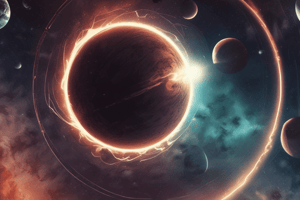Podcast
Questions and Answers
A total solar eclipse occurs when the Moon passes between the Sun and Earth, but not perfectly aligned.
A total solar eclipse occurs when the Moon passes between the Sun and Earth, but not perfectly aligned.
False (B)
Lunar eclipses can be seen with the naked eye, but solar eclipses require special safety measures.
Lunar eclipses can be seen with the naked eye, but solar eclipses require special safety measures.
True (A)
There are only two types of eclipses: solar and lunar.
There are only two types of eclipses: solar and lunar.
True (A)
The Earth's shadow falls on the Sun during a lunar eclipse.
The Earth's shadow falls on the Sun during a lunar eclipse.
An annular solar eclipse occurs when the Moon passes between the Sun and Earth, completely obscuring the face of the Sun.
An annular solar eclipse occurs when the Moon passes between the Sun and Earth, completely obscuring the face of the Sun.
Solar eclipses occur when the Earth passes between the Sun and the Moon.
Solar eclipses occur when the Earth passes between the Sun and the Moon.
A total lunar eclipse occurs when the Moon passes through only part of Earth's umbra.
A total lunar eclipse occurs when the Moon passes through only part of Earth's umbra.
The Moon turns a striking red during a partial lunar eclipse.
The Moon turns a striking red during a partial lunar eclipse.
A penumbral eclipse causes the Moon to dim significantly.
A penumbral eclipse causes the Moon to dim significantly.
The total solar eclipse on April 8, 2024, will be visible in North and Central America.
The total solar eclipse on April 8, 2024, will be visible in North and Central America.
The annular solar eclipse on Oct. 2, 2024, will be visible in North America.
The annular solar eclipse on Oct. 2, 2024, will be visible in North America.
The total lunar eclipse on March 14, 2025, will be visible in Eastern Europe and Eastern Africa.
The total lunar eclipse on March 14, 2025, will be visible in Eastern Europe and Eastern Africa.
Study Notes
Eclipses: All You Need to Know
Eclipses are cosmic events that occur when the Earth, Moon, and Sun align in a specific configuration. These events are a result of the unique geometry of the Earth-Sun-Moon system and can be seen from various parts of the world. There are two main types of eclipses: solar and lunar. Solar eclipses occur when the Moon passes between the Sun and the Earth, casting a shadow on Earth, while lunar eclipses happen when Earth's shadow falls on the Moon.
Solar Eclipses
A solar eclipse is caused by the Moon passing between the Sun and Earth, casting a shadow over Earth. There are three types of solar eclipses:
- Total solar eclipse: When the Moon passes between the Sun and Earth, completely obscuring the face of the Sun.
- Partial solar eclipse: Occurs when the Moon passes between the Sun and Earth, but not perfectly aligned, resulting in only a portion of the Sun being obscured.
- Annular solar eclipse: The Moon passes between the Sun and Earth when it is near its farthest point from Earth, with the Moon appearing smaller than the Sun and creating a ring of light around the Moon.
Lunar Eclipses
Lunar eclipses occur at the full moon phase and are visible from half of the Earth. These eclipses can be seen with the naked eye, unlike solar eclipses, which require special safety measures. There are three types of lunar eclipses:
- Total lunar eclipse: The Moon moves into the inner part of Earth's shadow, known as the umbra, dimming and sometimes turning the lunar surface a striking red over the course of a few hours.
- Partial lunar eclipse: The Moon passes through only part of Earth's umbra, with the shadow growing and receding without ever entirely covering the Moon.
- Penumbral eclipse: The Moon travels through Earth's penumbra, the faint outer part of its shadow, causing the Moon to dim slightly, which can be difficult to notice.
Upcoming Eclipses
Solar Eclipses:
| Date | Eclipse Type | Geographic Region of Visibility |
|---|---|---|
| April 8, 2024 | Total | Mexico, US, and Canada (partial eclipse in North and Central America) |
| Oct. 2, 2024 | Annular | South America (partial eclipse in South America, Antarctica, Pacific Ocean, and Atlantic Ocean, North America) |
| March 29, 2025 | Partial | Europe, Asia, Africa, North America, South America, Atlantic Ocean, Arctic Ocean |
Lunar Eclipses:
| Date | Eclipse Type | Geographic Region of Visibility |
|---|---|---|
| March 25, 2024 | Penumbral | Americas |
| September 18, 2024 | Partial | Americas, Europe, Africa |
| March 14, 2025 | Total | Pacific, Americas, Western Europe, Western Africa |
Eclipses are fascinating celestial events that have been observed and studied for centuries. They provide valuable insights into the workings of the solar system and offer a unique opportunity to witness the alignment of the Sun, Moon, and Earth.
Studying That Suits You
Use AI to generate personalized quizzes and flashcards to suit your learning preferences.
Description
Learn about the celestial events of solar and lunar eclipses, including their types, causes, and visibility. Discover the unique geometry of the Earth-Sun-Moon system and get insights into the workings of the solar system.




